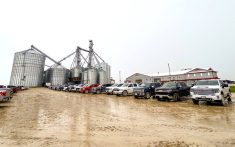Like many long-time players in Ontario’s agriculture innovation space, Dave Smardon is well aware that the space is crowded, efforts are fragmented and innovators are starved for funding.
The CEO of Bioenterprise, a non-profit organization that since 2003 has helped more than 2,500 companies commercialize agricultural technology, recognizes the value of competition to drive innovation, but he also sees how a lack of co-ordination can delay bringing new ideas to market.
For one thing, it leads to duplication, Smardon said in a recent interview.
“Currently what we have is a highly fragmented landscape across the country,” says Smardon. “There’s a fair amount of duplication of resources. We have a fairly large number of players, incubators, accelerators, or some other form of service providers, but they are grossly under-financed or resourced.”
Why it matters: There is no shortage of innovation to support Canada’s continued growth as an agricultural exporter, but a fragmented approach is leading to duplication and delays in commercialization.
A decision last fall by the Ontario government to pull foundational funding from Bioenterprise as well as for Ontario Agri-Food Technologies and Oilseed Innovation partners, two of its co-tenants in the University of Guelph’s research park, has prompted a movement to create a larger organization to oversee agriculture technology commercialization.
The loss of funding for the three non-profit organizations is an opportunity to build something bigger, says Malcolm Campbell, vice-president of research at the University of Guelph.

- Malcolm Campbell.
“OMAFRA voted with its funds,” he said of the drop in funding for the three Guelph-based non-profits. “They are in the same office together, so it surprises me they didn’t conjoin programs and build out the ecosystem from there. Someone needs to step up and fill that gap.”
The new organization’s reach doesn’t need to stop at Ontario’s borders.
Smardon looks to the example set by Communitech for internet and data-based technology in Kitchener-Waterloo and the MARS Discovery District for medical sciences in Toronto.
Communitech is considered the gold standard for technology incubators, although Samantha Clark, who works in public relations for Communitech says they think of themselves as a community incubator. At Communitech’s building in Kitchener, startup companies and corporate enterprises come together to collaborate, improve their businesses and access technology. It works with others, like the University of Waterloo in its community, and across the country.
An agriculture and agri-food incubator could do the same, co-ordinating funding, companies and services so areas of the country get the service they need.
“The goal is not to eliminate the organizations that exist across the country,” says Smardon. “The key is to partner with them, increase their capacity and resources. We can do that through partnerships.”
Several organizations, including the University of Guelph and Bioenterprise have partnered with other organizations in separate submissions in a competition to form a national hub for agriculture and agri-food innovation.
The federal department of Innovation, Science and Economic Development (ISED) put together expert “tables” of leading sectors make recommendations on what is needed for those sectors to flourish. The agri-food table recommended the creation of a centre of excellence for agri-food innovation. ISED is currently evaluating proposals for that centre of excellence.
It could serve as the over-arching co-ordinator for agriculture and agri-food technology growth and solve some of the duplication and confusion around agriculture technology commercialization.
The University of Guelph has partnered with the Ontario Centres of Excellence, the Ontario Dairy Network and the Enterprise Machine Learning and Intelligence Initiative (EMILI) in Winnipeg to form the Canadian Agri-Food Ecosystem — Digital (CAFE-D) Network.
Campbell sees it as the Communitech of agriculture, based in Guelph, but connected across the country to organizations and companies working in agriculture technology.
“Incubators,” places where entrepreneurs can go to get help navigating finance, regulations and to build their networks, have proliferated.
Smardon says municipalities have made incubators part of their economic development strategies. Government funding flows from the federal government, to provinces and then to municipalities, so economic development funding has resulted in regional resources being creating — including for agriculture.
In addition to OAFT, Bioenterprise and Oilseed Innovation Partners, the City of Guelph is also delivering agriculture and food startup programs. The University of Guelph has licensed the successful accelerator program from the University of Waterloo. It also has the Gryphon’s Leading to the Accelerated Adoption of Innovative Research (LAAIR) program, in which researchers are selected to learn more about moving their technology from research to commercialization.
Across the country, the other leading agriculture universities are in the innovation game, along with other regional players like AgWest Bio in Saskatchewan and the PEI BioAlliance.
Few are forced or choose to be formally connected.
The end result is experiences such as that of IntelliCulture, a Waterloo-based startup with an app that helps farmers manage their tractors and trucks. The founders were all students at the University of Waterloo and so ended up in the well-formed pipeline for digital entrepreneurs there. Cole Powers, one of the founders, says they benefitted from being part for the Velocity Garage, a program for early innovators. The challenge for them was to connect to the agriculture network, funders and businesses they needed to take their product to the next stage.
They eventually connected with groups in Guelph, like OAFT and BioEnterprise, but there wasn’t one simple point of entry, and transition, like companies moving from Velocity to using Communitech’s resources. A single entity would have saved IntelliCulture ground work, says Powers.
Campbell says that there needs to be one point of entry. When an entrepreneur or investor walks through the door, there should be a clear process in which a navigator is assigned to make sure the innovator is moved to the correct resources and organizations that can help them.
Campbell says that there needs to be a physical presence, a nexus he calls it, where organizations, researchers, funders and entrepreneurs meet in one building.
“I would argue that we need a physical entity, a space that is the national headquarters, or ground zero for agri-food innovation in Canada,” he said.
The entity would still be highly connected to rural Ontario and Canada through other organizations and facilities.
Tyler Whale, president of OAFT isn’t so sure a building or “mausoleum” is needed. Create the hub to connect the rest of the players and pieces, he says. Agriculture is so decentralized across the province and the country, that one building isn’t needed.
Whether it involves a building or not, connecting innovators to farmers will be a key function, and one that would be made more efficient with one point of entry.
“Innovators have to be in touch with the buyers,” says Whale. There’s no sense innovating for farmers if the business idea will take too much time on the farm or costs too much, he says.
Is agriculture different from other technology sectors? The answer is yes in several ways including:
- The time to market is slower, as there are many different size and shapes to farms, and farmers are cautious about new technology until it shows a definite return on investment.
- Regulations are different. Agriculture and food is highly regulated and regulations in some areas are stricter than other jurisdictions.
- The sector is diverse and geographically focused. That means that entrepreneurs may have to change their project depending on regions in Canada — which is already a smaller market.
- Agriculture hasn’t been ‘sexy’ to investors, although that is changing.
- Government hasn’t traditionally seen agriculture as an engine for growth and so it hasn’t seen its share of innovative funding models that other sectors have seen. That too appears to be changing.


















